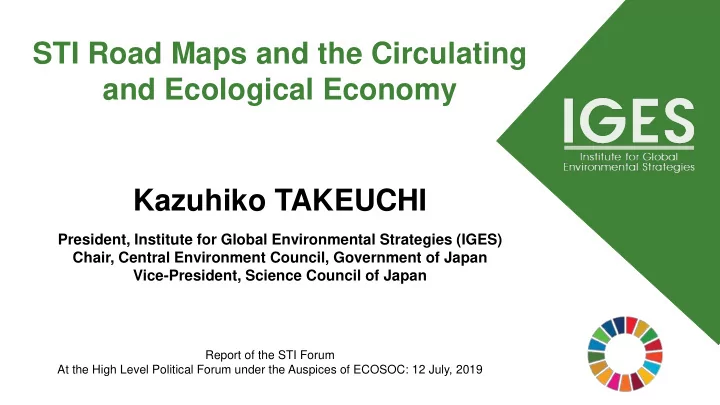

STI Road Maps and the Circulating and Ecological Economy Kazuhiko TAKEUCHI President, Institute for Global Environmental Strategies (IGES) Chair, Central Environment Council, Government of Japan Vice-President, Science Council of Japan Report of the STI Forum At the High Level Political Forum under the Auspices of ECOSOC: 12 July, 2019
Key Takeaways from the STI Forum Co-Chairs’ Summary 1. Para 27. The challenge is to design STI policies and instruments for the SDGs that translate the universality principle of the Goals into action, while respecting national science, technology and innovation priorities and realities…. 2. Para 36. STI road maps to achieve the Goals need to be customized to fit the circumstances within countries and, at the same time , be harmonized worldwide as a means to structure the necessary knowledge and match problems with solutions. & Para 37. Main elements of the implementation of the road maps include the localizing, mobilizing, prioritizing and customizing of STI. 3. Para 39. Further international support, Member State engagement and partnerships with donors and the private sector will be needed to fill the critical gaps in data, finance and effective implementation. & Para 69. International partnerships could promote increasing investments in research 2 and development and in demonstration projects for climate technologies.
Road Map for Integrated Achievement of the SDGs 3
Regional / Local Circulating and Ecological Sphere (CES) 4
Next Generation Local Energy Model for Kitakyushu City 5 5 5
STI Collaboration with Developing Countries Case Study in Semarang City, Indonesia u Semarang’s City Resilience Strategy (CRS): One of its pillars aims to improve the city’s public transport system by enhancing management and service quality u Importance of improving transportation: brings multiple benefits - mitigation of climate change and environmental pollution; new economic opportunities (jobs, markets); competitive human resource development (schools, social interaction), and others. u Transformative processes: encouraged by policy-oriented research activities, multi- stakeholder participation to practical actions to change younger generation’s 6 behaviour and project developments on 3 Low Carbon Transport system .
Recommend
More recommend